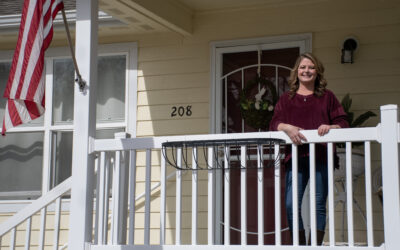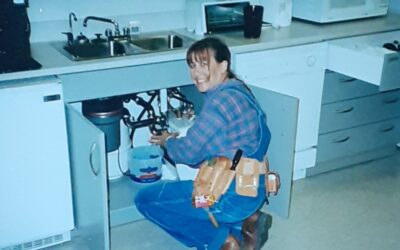
Project Demolition: Building Communities
Habitat for Humanity of Omaha is known as a nonprofit organization that builds affordable housing. It’s in the vision, “a world where everyone has a decent place to live.” But construction is not the only way that Habitat Omaha empowers the community and its members. Sometimes, Habitat Omaha does this by providing a clean slate. This is where the Project Demolition comes in.
Condemned and abandoned properties can hinder economic development or cause safety issues for both the city and neighbors. Project Demolition aims to eliminate these blighted homes and allow room for these neighborhoods to grow.
Elizabeth Osborn, an Environmental Inspector for the City of Omaha, sees firsthand the effect abandoned properties have in their communities. “The neighbors have lived there their whole lives and through no fault of their own, someone didn’t take care of it [their property], or died, and no one’s dealing with the problem.” These condemned properties often become an eyesore in the neighborhood due to unwanted activities such as dumping junk and debris.

The City of Omaha teamed up with Habitat Omaha to address this problem by taking down the houses. This can be challenging since some properties are tied up in red tape or the logistics of finding the homeowner can be incredibly time consuming.
“The program is the most effective use of resources,” Osborn says. She spends most of her time surveying safety concerns and coding violations. “The houses become a sight for illegal activities, break-ins, and tearing off siding.” Project Demolition looks to prevent these behaviors by taking down the properties.
“Almost, without fail, the dumping stops once the house is taken down,” Osborn shares. “Our [the City of Omaha] resources are being used to clean, mow and police these properties. Firefighters are constantly going in to put out fires. These properties are the biggest headaches for these departments.” Her biggest wish is for people to understand the huge significance, not just for neighbors but the community, when these structures are taken down.

Douglas Krysl, Battalion Chief of Omaha Fire Investigation Unit, says fire hazards commonly occur when these properties are illegally occupied by squatters or vagrants. “They sometimes start small fires to keep warm and these sometimes get out of hand.” Project Demolition is a valuable tool because it reduces the number of “emergency incidents which put firefighters in danger while fighting fires in these structures. There’s an increased chance for dilapidation and related dangers to firefighters if they are called to fight fires in these structures.”
The Fire Investigation Unit makes sure to flag these dangerous properties they encounter so the rest of the fire department has on file that this is a structure to approach with caution. The Omaha Permits and Inspections Division is also notified about these properties so they can be observed more closely. Unfortunately this necessary caution takes up valuable resources that could be delegated elsewhere.
“Abandoned homes are often left unsecured, becoming safety concerns for curious neighborhood children,” explains Scott Gray, Deputy Chief of Omaha Police. “Criminals use abandoned house in which to hide, conduct various types of illegal activity, or hide contraband. Abandoned homes often become dump sites for garbage, tires, and hazardous chemicals. Additionally, many of these homes are badly deteriorated, making them unsafe for anyone to enter.”
Gray adds that there are safety risks to the men and women who serve the citizens of Omaha.
“Criminals use abandoned houses to conceal themselves or criminal evidence. Officers can be injured by these criminals or by the hazards presented by the deteriorated structure itself. Abandoned homes are often the targets of arsonists, creating danger to surrounding structures and to any responding fire department personnel.”
The biggest challenge Gray and his department face are the constant complaints about dilapidated homes and the frustration they face from the community when there is no immediate resolution. The owners of the homes have often passed on, live out of state, or simply abandoned the building. Understandably, getting in touch and working with the homeowner can be difficult at best. Homes owned by the bank aren’t much better, often tangled in legal processes, which can lead them to sitting empty for years. Project Demolition addresses a very real problem.
“Some abandoned homes are too deteriorated to effectively rehab, so demolition and new construction are often the best option. I think many residents are overjoyed to see the removal of houses that have been eye sores in the community. They also welcome the new construction, increased property values, and fresh life brought to a neighborhood as a result.”

Eulyssa Vaughan is one of many homeowners that live next to such a property. The house has been vacant for 4 years and condemned for the last year.
“I am embarrassed to have visitors and rarely invite anyone over. We live directly across from this home and it is an eyesore and a safety and fire hazard! This is especially the case during the spring and summer months when the yard gets overgrown with weeds and grass. The neighbors and I have gone over there on a few occasions to trim the hedges just to make it look more presentable. Having this home in this condition for this amount of time gives the impression to outsiders that we don’t care! This couldn’t be further from the truth.”
These abandoned properties have other unexpected consequences. Vaughan shares that the home has become a breeding ground for raccoons and stray cats. “In August 2017, a raccoon crawled under the hood of my mother’s Hyundai Sante Fe, and ate through the electrical wiring harness. Of course, this is not covered under warranty and was $175 to repair!” This happened to her twice in the same month.
Living next to one of these properties can also wear on the homeowners’ moral.
“This house has been the bane of our existence for many years now. It’s obvious that it’s driving the property values of surrounding homes down. Not to mention, it adds to the already present stigma about North Omaha and those that reside here—that many of us don’t care about or take care of our properties. Conversely, there are many hard working, upstanding residents of this area that do care about their community and want to keep their neighborhoods safe, clean, and in aesthetically appealing.”
Vaughan believes that Project Demolition is a great idea and looks forward to the house being demolished so that a new home can be built in its place.
“We, on this block in particular, are all quiet, hardworking, and honest people that care about our community, and we all keep our property up.” She adds. “I would like to see a family of the same mindset and values move into the home.”

Project Demolition isn’t just about tearing down houses. It tackles an issue that many members of the community face every day. The Habitat Omaha program works in conjunction with other departments of the city of Omaha to wipe away dangers to safety and bring back homeowner pride.
“Programs that seek to rehabilitate communities and bring hope to residents are extremely welcome.” Gray shares. “One of the keys to improving a community’s morale is creating stability and pride in one’s neighborhood.”
This clean slate is a win-win for everyone involved, city and individuals alike. It is one part of the puzzle to bring to life Habitat Omaha’s vision of “a world where everyone has a decent place to live.”
“Habitat Omaha really builds the community up,” says Osborn. “As far as the whole package, they’re not just building houses, but they understand the needs of the neighborhoods and are looking at the big picture.”






